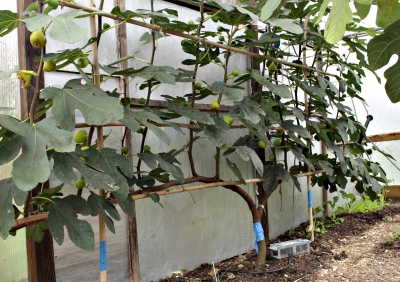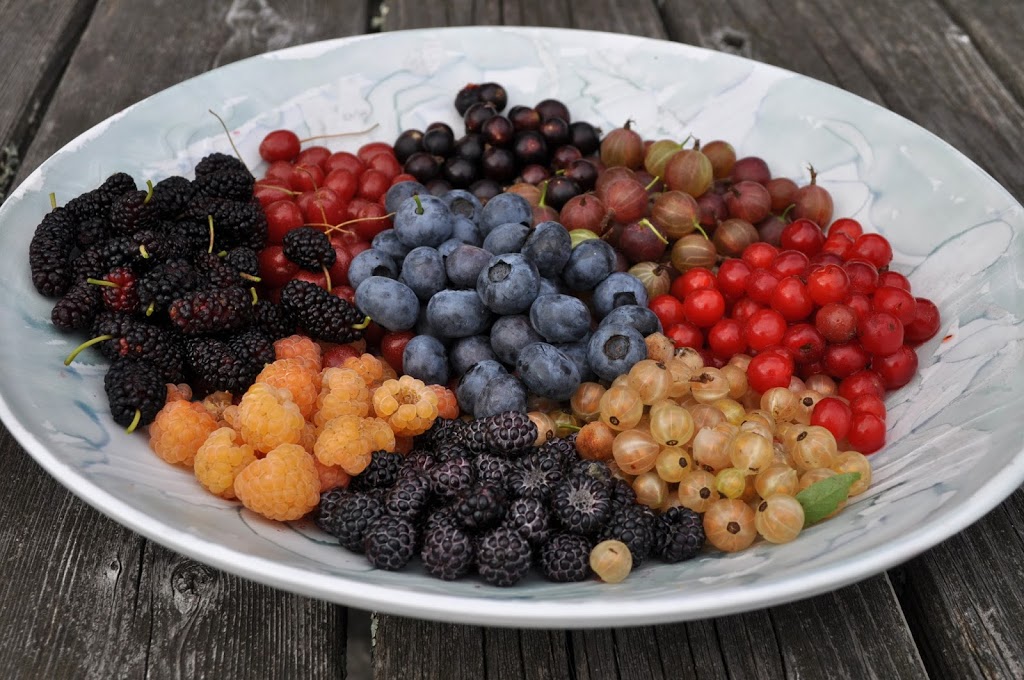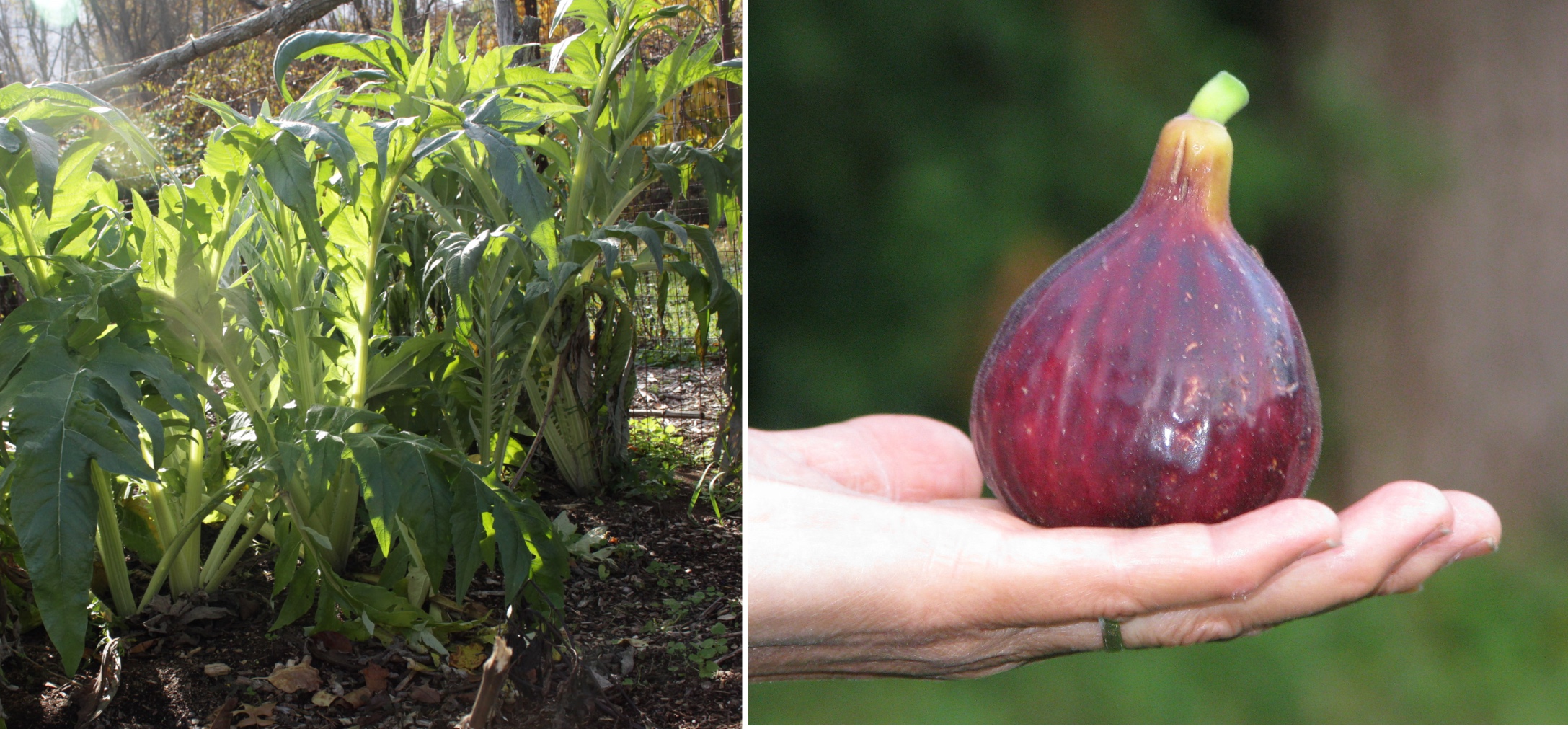FIGS UP NORTH
Who Says I Can’t Grow Figs? A Mouse?
Crisp weather notwithstanding, almost every day I can reach up into the branches of my fig trees and walk away clutching a handful of soft, dead-ripe fruits. That’s because the trees, the ones bearing fruit, are in the greenhouse, where nights are chilly but daytime temperatures, especially on sunny days, are balmy or hot.
I’m not gloating. Those greenhouse figs take some work beyond normal routines of keeping heating, cooling, and watering systems chugging along harmoniously in the greenhouse. Earlier in the season I battled cottony cushion scale insects with toothbrush and soapy water, with oil sprays, and with sticky band traps (for ants, which “farm” scale insects) on trunks. Now I see the insects are staging a comeback at a time when the trees are too big to scrub with a toothbrush and too big, too laden with fruit, and surrounded too closely by lettuce, celery, and other winter edibles to spray oil. I’m hoping natural conditions keep scale insects in check until cold weather and lack of leaves or fruit finally puts them asleep for a few months.
A few weeks ago, some creature — a mouse is my guess — discovered the figs, and liked them. He, or she, chewed the bottoms of some fruits as they hung from branches and gathered others to cache in shallow tunnels. Traps, poison bait, and wide girths of sticky Tangle-Trap returned fruits to their rightful owner, me.
All this effort is worthwhile. Especially on sunny days, the figs are delectable, soft and sweet like dollops of jam hanging from the branches.
So Many Varieties, So Little Space
Growing a few varieties of figs makes fig-eating even more pleasurable. People wonder, on hearing that I grow figs, whether I grow “brown figs or white figs,” at which point I bring attention to the fact that there are hundreds of varieties of figs, with many of each color.
I keep trying to pare down my collection to the best. Instead, I seem to be adding varieties either deliberately or gifted. It’s hard, virtually impossible, to tell what variety you have until it fruits. Figs have been cultivated for thousands of years, along the way of which an older variety may have picked up many names. For instance, I have a variety I purchased as Verte (syn. Green Ischia); with brown fruit, I knew it was mislabeled. Its bearing habit and the appearance of the fruit nailed it down as San Piero, also known as Negro Largo, Douro Black, Aubique Noir, Large Blue, Lee’s Perpetual, and California Brown Turkey, among other names. The name California Brown Turkey distinguishes it from Eastern Brown Turkey, a totally different variety that I also grow and which itself is also known as English Brown Turkey, Everbearing, and Texas Everbearing,.
A few years ago, a woman on Millrock Road here in town, offered me her potted fig tree; she was moving and didn’t want to take it with her. (Understandable: I also didn’t take all my 35 varieties of fig from my garden in Maryland when I moved up here to the Hudson Valley.) Still hers was an offer I could not refuse; perhaps that potted plant would bear the best fig ever. In a pot in the greenhouse this year, the tree finally bore fruit, greenish yellow and round, with the insides bursting to split the skin. It’s a keeper, and I’m adding to the nomenclature confusion by calling it Millrock fig until I learn otherwise.
Another fig, this one named by Jack Algiere, the farmer at Stone Barns farm, is bearing heavily and looks to keep doing so for weeks to come. I have espaliered this tree, Rabbi Samuel, against a greenhouse wall in the form of a permanent, low T. Fruiting shoots rise vertically about 6 inches apart from the upper side of each arm. This variety bears best on new shoots so my plan is to each winter cut all vertical stems down near the arms and then thin out new growth so vertical shoots are no closer that 6 inches apart. The Rabbi’s fruits are humongous, as big as small apples.
Subtropical, But Thankfully Adaptable
What makes figs so popular a fruit, even in climates far removed from the hot summers and mild winters it calls home? Perhaps a love for this ancient fruit, whose provenance is in one cradle of civilization, is coded into our DNA. And, of course, the flavor, sweet and juicy without being cloying.
Although a subtropical plant, fig is accommodating to colder climates. You can hack back its roots — useful when providing new potting soil for pot-grown plants. It’s deciduous, so doesn’t need light in winter — useful in northern climates when looking for a cold, but not too cold, place to store the dormant plant. Most varieties do not need pollination to set fruit. And figs bear quickly and propagate easily.
Most important, in contrast to most temperate-zone fruits, fig plants can bear on new wood. Some varieties bear on one-year-old wood and some bear on both old and new wood. Bearing on new wood — as does Rabbi Samuel — makes it convenient to cut back a potted plant when maneuvering it indoors for winter. Or if winter cold kills part of the top of an outdoor plant. In either case, a plant that loses too much of its top requires a longer growing season before fruits start ripening.
Fruits keep ripening along new shoots, as they grow, until arrested by cold. Hence, my prediction for a few more weeks of fruit from Rabbi Samuel in the greenhouse. Those fruits hang in stark contrast to the scene outdoors, where leaves of tomato, pepper, and other tender plants have been blackened by the first killing frost here of 25°F, on October 19th.








Want to ID your figs? Post pictures of leaf shape, fruit interior and exterior onto Figs4fun forum and I’m sure some of the fignatics there could give you a solid idea should you care to find out.
Figs4fun is a great website for us fig lovers.
So, my Turkish Brown fig is full of fruit. I had to bring it indoors again this winter. It was a gift last August. I am in zone 3. Will my fruit ripen indoors at 50 degrees or should I give up hope?
Mostly, what it needs is light in abundance. The temperature is fine but it needs a south facing window in full sunlight — or a greenhouse.
Hi,
Thanks very much for your blog, you’ve inspired me to espalier my own figs! I’m trying the T design like you suggest, but was wondering if you mind sharing any other espalier designs you have had success with. I live in Australia, so no greenhouse needed, but the espalier makes netting for the birds much easier. What spacing do you usually need for espalier figs? I’ve given mine 5m, but would love to hear your experience.
Many thanks ,
Jasmine
Spacing depends on how much you prune them, what variety you plant, and the richness of your soil. Figs are very adaptable as far as pruning.
Hi. I have started to espalier a fig against a fence and wondering how and when to prune. Do I cut it back after leaves have dropped off? Do I cut back to the main branches or leave small trains to start again next year? I am in NZ so seasons are opposite here. Thanks Kim
I do major pruning in dormant season, when plants are leafless.During the growing season I pinch back or cut off shoots that are growing where I don’t want.
Hello,
I need help! I have a 5 year old Mission tree in a pot that is currently producing fruit( although late this season) the thumb nail size fruit is turning red.
It has never happened before, any ideas why?
Please let me know what you might suggest.
Thank you
Sharon. Zone 6
Too much or too little water? Mission mostly bears a “main crop” of fruit so pruning a little more severely in winter would encourage those. Those little ones might be “brebas” that were never going to develop.
I am new to greenhouse use. What temperature range is best for hardy fig? Does it need a few days out in the cold to produce?
Yews, it likes some winter cold, ideally between about 30 and 45 degrees F.
I live in zone 7b Tennessee. Will the figs do well in a green house or do they still need to be swaddled and or just pruned. I insulated my outdoor figs with straw bales and leaves, wood chips, and thick cardboard
Just pruning would probably get your plants through most winters to go on and fruit that season. But just a bit of swaddling would definitely do it. Stems tolerate winter cold down to the ‘teens.
I am trying to grow and espalier fig and fuyu kaki (started from seed) in my high tunnel. Bumbling along is an apt description. It’s the first year for both and they are in 16 inch raised beds.
How to prune this first year…I could send pics if you would kind enough to help.
We, I believe, have a mutual friend in John Bartok the greenhouse master.
Thank you,
Timmy
Quoting directly from my book GROWING FIGS IN COLD CLIMATES (which I recommend to you): Along the back wall of my greenhouse, I trained one fig plant to the shape of a low branching T. Training began right after planting, when I removed all but one vertical stem. When the stem, which I will now call a “trunk,” reached about 18″ in height I pruned off the tip, which caused buds just below the cut to grow out into shoots. I selected two, on opposite sides of the trunk, and trained them (they are now called “cordons”) in opposite direc- tions along a temporarily mounted, horizontal bamboo cane.
Figs planted at the heads of each of the greenhouse beds were trained similarly, minus one of the cordons of the T. With two opposing cordons, like the back wall fig, the plants would have blocked the main path of the greenhouse which runs perpendic-ular to the beds.
In early spring, new shoots appear. The goal is upright shoots originating about 8″ apart along the cordons; to that end I prune away any shoots that are growing downwards or crowd closer than 8″ from a neighbor. To keep everything neat and orderly I attached thin bamboo canes to the greenhouse roof to reach down to the cordons, one cane at each location of an upright. Each cane provides an anchor for each upwardly mobile, new fig shoot.
Shoots eventually grow roof-height so I cut back the tops a bit, as needed, and shorten side branches that then develop near that growing tip. The same goes for other side branches that might develop lower down along the growing shoots.
Major pruning takes place at season’s end, and it’s very easy. In addition to cutting back any root sprouts or new shoots develop- ing along the trunk, I cut every vertical shoot down to the cordon from which it sprang. And once a cordon has grown the desired length, I cut all new growth from its tip back to its origin for that season. That’s it!
Yes, Bartok is the greenhouse master.